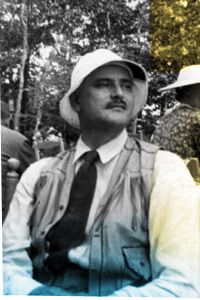            |
 |
 
 |
 |
 |

- - - - - - - - - - - - - - - - - - - -
 The best nature-writing, it seems to us, brings together a place, a time, and a personality in such a way that, after we've read the book, the writer's experience, and something of his or her personality, seems to be our own. When we think of Henry Beston's Cape Cod, Annie Dillard's Blue Ridge, Rachel Carson's Maine coast or Florida Keys, we imagine not a clinical, purely objective landscape but a personal one, a place colored by the particular sensibility, the individual filter, through which it passed. The American Southwest of Edward Abbey is one place; and although the geographical territory may be the same in the writings of Wallace Stegner or Terry Tempest Williams, our sense of it --- the things we notice and choose to look at, the way we look at them and the questions we ask --- is different. With nature-writers, the lens is personality --- and that makes all the difference. Henry Beston produced a masterpiece on Cape Cod, but he did not say the last word; treading the same sacred ground today, John Hay and Robert Finch point to signs that only they have noticed. This subjective quality distinguishes nature-writing from natural history, and keeps it fresh: the source is inexhaustible, and each inquiry unique as the personality which makes it. The best nature-writing, it seems to us, brings together a place, a time, and a personality in such a way that, after we've read the book, the writer's experience, and something of his or her personality, seems to be our own. When we think of Henry Beston's Cape Cod, Annie Dillard's Blue Ridge, Rachel Carson's Maine coast or Florida Keys, we imagine not a clinical, purely objective landscape but a personal one, a place colored by the particular sensibility, the individual filter, through which it passed. The American Southwest of Edward Abbey is one place; and although the geographical territory may be the same in the writings of Wallace Stegner or Terry Tempest Williams, our sense of it --- the things we notice and choose to look at, the way we look at them and the questions we ask --- is different. With nature-writers, the lens is personality --- and that makes all the difference. Henry Beston produced a masterpiece on Cape Cod, but he did not say the last word; treading the same sacred ground today, John Hay and Robert Finch point to signs that only they have noticed. This subjective quality distinguishes nature-writing from natural history, and keeps it fresh: the source is inexhaustible, and each inquiry unique as the personality which makes it.
The Outermost House presents us with a time, a place, and a man. The time and place, Cape Cod in the mid-1920's: a wild, windswept outpost of the land. Dominated by ocean and weather, this landscape has been long inhabited but never domesticated. Here, to a tiny house set alone on a dune above the sea, a man has come in solitude to watch, and listen, and bear witness. He watches on winter nights as fishing schooners, last vestiges of the age of sail, move slowly beyond the bar, or come to frozen grief upon it. He listens to the myriad voices of the surf, and attempts, in words, a faithful notation of the music he has heard. He bears witness to the comings and goings of constellations and tides, the nightly patrols of the coast guardsmen who walk the beach; he ponders the dark imperatives that lie behind the migrations of birds and fish, the mysterious "peoples of the sea." Into the vast bright days of autumn he goes, and we go with him, gathering driftwood against the winter nights; in spring we walk inland over the greening moorland, off to meet the alewife run; in summer we kindle our cooking fire on the beach, and sleep between sand-dunes as the constellations wheel above us.
Is this not the life we all dream of?
Through Beston's pages, we share it: and who among us, reading his words and imagining them as they flowed from his pen in the yellow lamplight of the house above the sea, has not seen himself seated there at the kitchen table, composing his thoughts, recording his observations, posing his eternal questions as the fire roars in the grate and winter bears down on the dark and desolate world outside?
Other writers have dealt with Henry Beston's command of the language, his talent for the magisterial phrase, the telling detail, the vivid sensory impression. Others have examined his belief that "poetry is as necessary to comprehension as science," his reminder that "creation is here and now," his living admonition that we look, and pay attention, and participate in the "burning ritual of the year." For a thorough and insightful treatment of Beston's life and language and thought, we know of no better essay than Robert Finch's introduction to The Outermost House.
That being said, we will suggest only this, as perhaps the strongest reason that The Outermost House is so special a book for so many of us: Henry Beston gives us, through language we would love to possess, a world we would love to live in, and a way we would love to live.
- - - - - - - - - - - - - - - - - - - -
|
 |
 |
|
|



